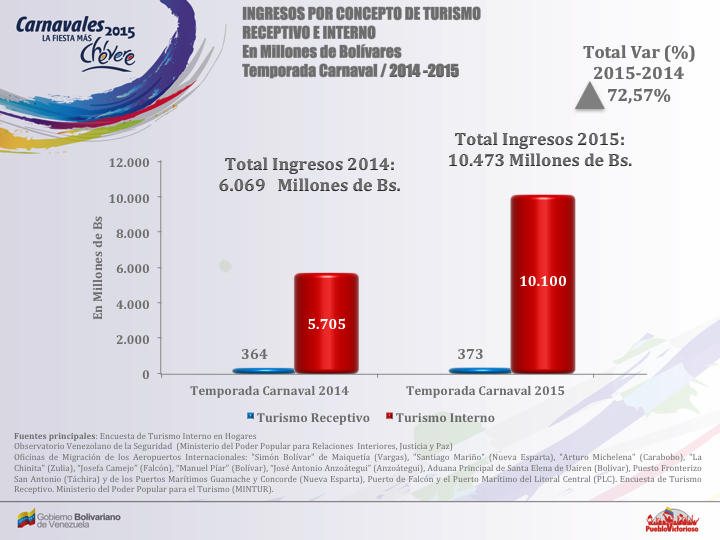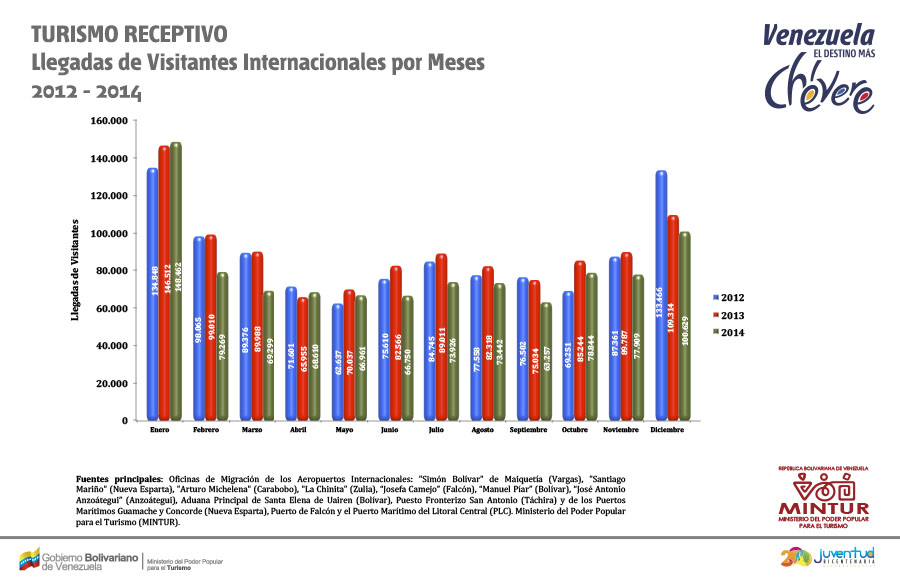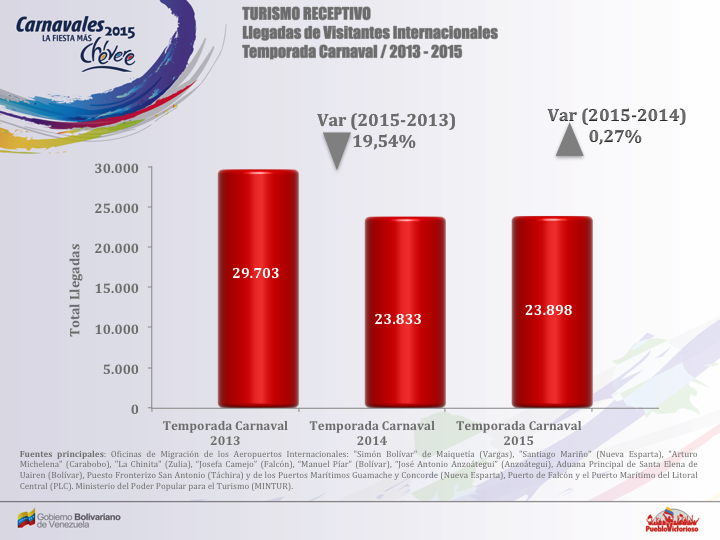CARACAS Venezuela (ViaNews) - It is well known that Venezuela has enjoyed times when high rates of tourists entering the country were public and notable.
However, in recent decades foreign tourism has decreased dramatically, to the point that the data and indicators do not represent a significant figure in the annual economic reports.
Taking into consideration the information provided by the Ministry of People's Power for Tourism (Ministerio del Poder Popular para el Turismo), an official source, the latest statistics published are from the years 2013, 2014, and 2015 on Carnival and Easter times. Thus, there is a quantitative gap to know the behavior of tourism in subsequent years.
Regarding receptive tourism in the period of Carnival, it is found that through a comparative study provided by the official website, revenue figures for 2014 were 6,069 million VEF and by 2015 was 10,473 million VEF. Taking into account the high inflation rate of the national economy, this does not represent a higher income for the country.
[caption id="attachment_3246" align="aligncenter" width="720"]

Graph 1: Receptive and Intern tourism incomes (2014-2015). Source: Ministry of People's Power for Tourism.[/caption]
Likewise, it is remarkable that from 2012 to 2014 there was a gradual decrease in international visitor arrivals, stopping abruptly in 3 years.
[caption id="attachment_3247" align="aligncenter" width="900"]

Graph 2. Receptive tourism (2012-2014). Source: Ministry of People's Power for Tourism.[/caption].
Another striking issue is how receptive tourism in the Carnival period 2013-2015 attracted fewer and fewer foreign tourists. This may be due to the well-known situation of insecurity that prevents the development of tourism for foreigners. It can be said that public policies on tourism have been directed towards the Venezuelan population, with the creation of “Venetur” hotel networks and other tourism packages with, still, very high costs.
[caption id="attachment_3248" align="aligncenter" width="720"]

Figure 3. Receptive tourism during Holidays (Carnival, 2013-2015). Source: Ministry of People's Power for Tourism.[/caption]
For the year 2013, there were 29,703 arrivals of international visitors, and by 2014 it decreased to 23,833 and in 2015 had a minimal increase, accounting for 23,898 foreign tourists.
The lack of a tourism policy might be a problem facing Venezuela because in times of crisis tourism has been an economic safeguard for many countries. The international media has been disregarding the official tourism safety guarantees and covering the critical situation of urban and rural insecurity which puts into risk the safety of foreigners inside the country.
Another issue that seems alarming is the absolute absence of tourism numbers and data over the last two years: 2016 and 2017. The question remains on how to measure the numbers of travelers during this year. In addition, there were some really interesting events for the tourism sector, such as the reopening of the Mukumbari aerial lift in the state of Merida in October 2016, which led to more than 377,000 tourists, according to a Radio Mundial report by Magdalena Valdez. It is located at an altitude of 4,765 meters above sea level and was highly reported in the media, generating an impact on the tourism sector.
However, that kind of initiatives hadn't sufficient international visibility to attract foreign tourists, which can be attributed to the same insecurity issues previously mentioned. Could international tourism advertising strategies create mechanisms for attracting more tourists? Undoubtedly, a well-established tourism sector is something the State and the private sector should aim at in order to avoid the longstanding oil-based economy dependence.
 Graph 1: Receptive and Intern tourism incomes (2014-2015). Source: Ministry of People's Power for Tourism.[/caption]
Likewise, it is remarkable that from 2012 to 2014 there was a gradual decrease in international visitor arrivals, stopping abruptly in 3 years.
[caption id="attachment_3247" align="aligncenter" width="900"]
Graph 1: Receptive and Intern tourism incomes (2014-2015). Source: Ministry of People's Power for Tourism.[/caption]
Likewise, it is remarkable that from 2012 to 2014 there was a gradual decrease in international visitor arrivals, stopping abruptly in 3 years.
[caption id="attachment_3247" align="aligncenter" width="900"] Graph 2. Receptive tourism (2012-2014). Source: Ministry of People's Power for Tourism.[/caption].
Another striking issue is how receptive tourism in the Carnival period 2013-2015 attracted fewer and fewer foreign tourists. This may be due to the well-known situation of insecurity that prevents the development of tourism for foreigners. It can be said that public policies on tourism have been directed towards the Venezuelan population, with the creation of “Venetur” hotel networks and other tourism packages with, still, very high costs.
[caption id="attachment_3248" align="aligncenter" width="720"]
Graph 2. Receptive tourism (2012-2014). Source: Ministry of People's Power for Tourism.[/caption].
Another striking issue is how receptive tourism in the Carnival period 2013-2015 attracted fewer and fewer foreign tourists. This may be due to the well-known situation of insecurity that prevents the development of tourism for foreigners. It can be said that public policies on tourism have been directed towards the Venezuelan population, with the creation of “Venetur” hotel networks and other tourism packages with, still, very high costs.
[caption id="attachment_3248" align="aligncenter" width="720"] Figure 3. Receptive tourism during Holidays (Carnival, 2013-2015). Source: Ministry of People's Power for Tourism.[/caption]
For the year 2013, there were 29,703 arrivals of international visitors, and by 2014 it decreased to 23,833 and in 2015 had a minimal increase, accounting for 23,898 foreign tourists.
The lack of a tourism policy might be a problem facing Venezuela because in times of crisis tourism has been an economic safeguard for many countries. The international media has been disregarding the official tourism safety guarantees and covering the critical situation of urban and rural insecurity which puts into risk the safety of foreigners inside the country.
Another issue that seems alarming is the absolute absence of tourism numbers and data over the last two years: 2016 and 2017. The question remains on how to measure the numbers of travelers during this year. In addition, there were some really interesting events for the tourism sector, such as the reopening of the Mukumbari aerial lift in the state of Merida in October 2016, which led to more than 377,000 tourists, according to a Radio Mundial report by Magdalena Valdez. It is located at an altitude of 4,765 meters above sea level and was highly reported in the media, generating an impact on the tourism sector.
However, that kind of initiatives hadn't sufficient international visibility to attract foreign tourists, which can be attributed to the same insecurity issues previously mentioned. Could international tourism advertising strategies create mechanisms for attracting more tourists? Undoubtedly, a well-established tourism sector is something the State and the private sector should aim at in order to avoid the longstanding oil-based economy dependence.
Figure 3. Receptive tourism during Holidays (Carnival, 2013-2015). Source: Ministry of People's Power for Tourism.[/caption]
For the year 2013, there were 29,703 arrivals of international visitors, and by 2014 it decreased to 23,833 and in 2015 had a minimal increase, accounting for 23,898 foreign tourists.
The lack of a tourism policy might be a problem facing Venezuela because in times of crisis tourism has been an economic safeguard for many countries. The international media has been disregarding the official tourism safety guarantees and covering the critical situation of urban and rural insecurity which puts into risk the safety of foreigners inside the country.
Another issue that seems alarming is the absolute absence of tourism numbers and data over the last two years: 2016 and 2017. The question remains on how to measure the numbers of travelers during this year. In addition, there were some really interesting events for the tourism sector, such as the reopening of the Mukumbari aerial lift in the state of Merida in October 2016, which led to more than 377,000 tourists, according to a Radio Mundial report by Magdalena Valdez. It is located at an altitude of 4,765 meters above sea level and was highly reported in the media, generating an impact on the tourism sector.
However, that kind of initiatives hadn't sufficient international visibility to attract foreign tourists, which can be attributed to the same insecurity issues previously mentioned. Could international tourism advertising strategies create mechanisms for attracting more tourists? Undoubtedly, a well-established tourism sector is something the State and the private sector should aim at in order to avoid the longstanding oil-based economy dependence.
